Welcome Sweat Bees to Your Garden Throughout the Growing Season
Sweat bees get their common name from their behavior of landing on skin on hot summer days to feed on sweat. They can be very persistent when they have found a good source but are unlikely to sting you unless you accidentally squish them or swat them. Their main diet, like that of all bees, is pollen and nectar produced by flowers. These medium-size bees are active from spring through fall and need a consistent supply of food. For this reason, make sure you have at least three plants flowering at any given time throughout the growing season.
Unlike the majority of wild (native) bees, which have solitary nests, sweat bees (Halictus) are eusocial, with one female (queen) doing all the egg laying and her female offspring (workers) helping with foraging and rearing the developing brood. These bees can produce two or three generations in a given growing season. What is fascinating about this bee genus is that some species will nest socially in a geographic region that has a long growing season, while others have solitary nests in regions where the growing season is shorter, often in northern climates or high-altitude sites.
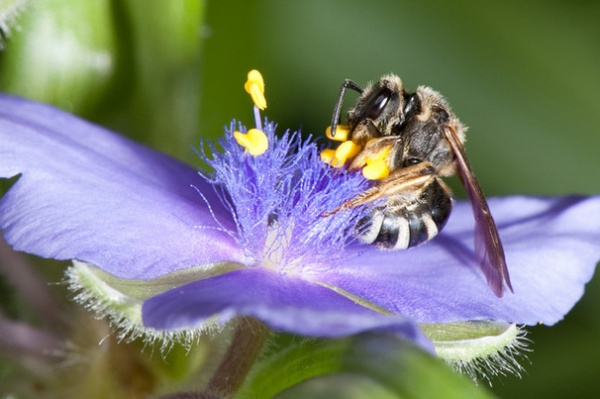
Genus: Halictus
Common name: Sweat bee
Numbers: About five subgenera and 10 species in North America (north of Mexico); seven species east of the Mississippi, including one introduced species (H. tectus); 200 species worldwide
Distribution: Sweat bees are found throughout most of the world except Australia, New Zealand and southern Asia, including Indonesia
Habitat: Woodland edges, gardens, meadows, prairies and old fields
When to look for them: Sweat bees are active as adults from spring through fall. In the northeastern U.S., nesting can occur as early as late April; females begin collecting pollen and nectar from flowers in spring, after establishing a nesting site. Some sweat bees have solitary nests, others nest communally, and some are primitively eusocial, nesting in colonies. A few Halictus species, including H. rubicundus and H. ligatus, have been found to have eusocial nests in warm climates and solitary nests in cool, northern or high-altitude climates, where a shorter growing and breeding season occurs.
Shown: A female sweat bee foraging for pollen on prairie spiderwort (Tradescantia bracteata)
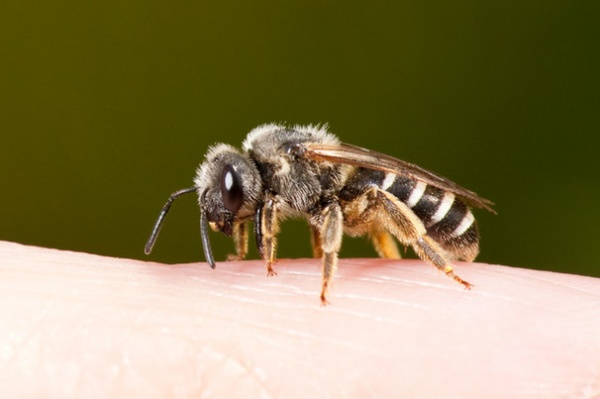
How They Help
Sweat bees effectively pollinate native plants, cultivated plants and, in some cases, food crops, including blueberries and strawberries. Most are small to medium size.
Shown: A female sweat bee seeking out sweat on human skin
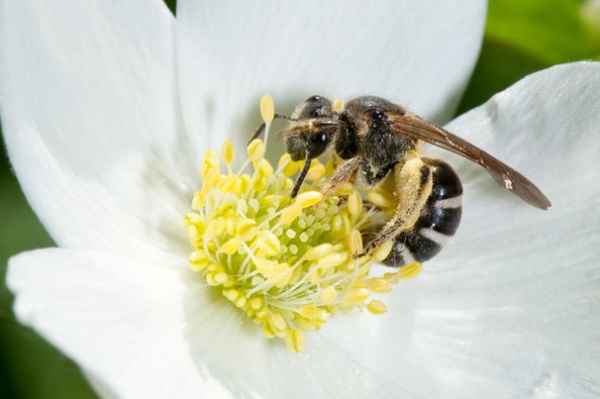
How to Spot Sweat Bees
Adult females. Sweat bees are black with white hairs at the top (apex) of each abdominal segment. Females have pollen-collecting hairs on their hind legs. Seeking out sweat, females will land on human skin on hot summer days. They feed on the sweat with their tongue, supplementing their diet with salt and possibly minerals.
Sweat bees (Halictus) can resemble the closely related small sweat bees in the Lasioglossum genus. Lasioglossum are typically smaller in size than Halictus and have pale hair bands at the base of each abdominal segment.
Adult males. Males usually have longer antennae than the females, a long and slender abdomen, and yellow on their legs.
Shown: A female sweat bee visiting Canada anemone (Anemone canadensis) for pollen
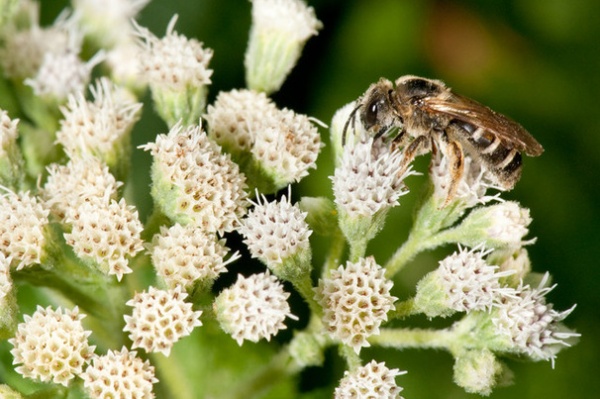
How to Lure Them
Sweat bees are generalist foragers and visit a wide variety of flowering plants, from spring through fall. They commonly forage on open flower forms, where pollen and nectar are easy to access.
Where they nest. Sweat bees nest in the ground, often in sites with bare soil that is well drained and easy to excavate. Nests can occur in large aggregations and can be solitary, communal or social.
Maintain a bee-safe yard. Do not use pesticides, especially insecticides, in your garden, particularly on your flowering plants.
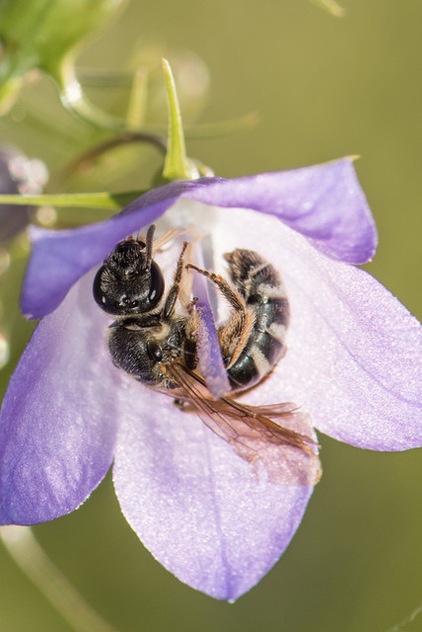
Forage plants for adults. All bees need a variety of flower forms and colors in the garden and a continuous succession of flowering plants. Sweat bees are active from April through October. Make sure you have something flowering at all times, or consider adding more flowering plants so that the buffet is always open to pollinators.
Some plants for adults:
Spring: Harebell (Campanula rotundifolia), violets (Viola spp), beardtongues (Penstemon spp), wild geranium (Geranium maculatum), Canada anemone (Anemone canadensis), spiderworts (Tradescantia spp), purple meadow-rue (Thalictrum dasycarpum) and Virginia waterleaf (Hydrophyllum virginianum)Summer: Black-eyed Susan (Rudbeckia hirta), vervains (Verbena spp), yellow coneflower (Ratibida pinnata), Culver’s root (Veronicastrum virginicum), swamp milkweed (Asclepias incarnata), Joe Pye Weeds and bonesets (Eupatorium spp) and leadplant (Amorpha canescens)Late summer and fall: Stiff goldenrod (Solidago rigida) and asters (any species)Browse native plants for your region
Shown: A female sweat bee on a harebell (Campanula rotundifolia) flower
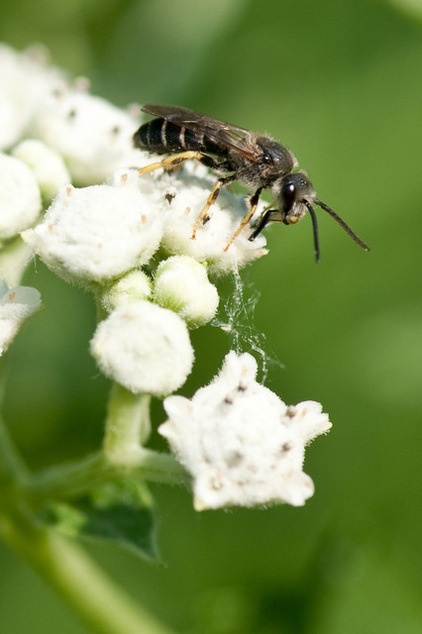
Life cycle. In the upper Midwest, Great Lakes and Northeast regions, sweat bees have eusocial nests. The nests often produce multiple generations in a given year or breeding season. The social nests of Halictus species produce females that mate in the fall and then overwinter, or in some cases the first brood produces females that overwinter in early summer.
When a nesting site has been established, the female begins collecting the first provisions (pollen and nectar), which are deposited in the ground nest in a brood cell. An egg is laid when there is enough food for a larva to feed and develop on.
Females in social nests with more than two generations initially produce female offspring that become workers, helping their mother with foraging and nest duties. The female that founded the nest in spring (the queen) will usually die in midsummer once her daughters are adults, then one of her reproductive daughters will continue to lay eggs. The third brood will produce females and males, which will mate. The mated females will overwinter and establish a new nest in the spring.
Shown: A male sweat bee on wild quinine (Parthenium integrifolium)
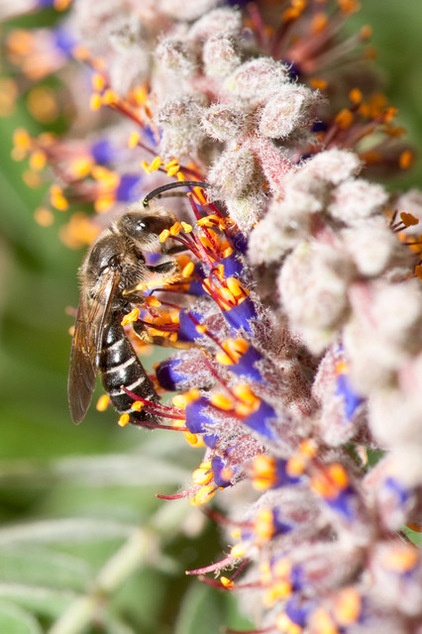
As the nesting area is potentially used throughout the growing season by sweat bees, it is important not to disturb it. If possible, leave the area unmulched and limit disturbance, including foot traffic and tilling.
Shown: A male bee foraging on lead plant (Amorpha canescens)
Region by region: What to do in your garden this month
More: How to Help Your Town’s Beneficial Birds and Bugs












